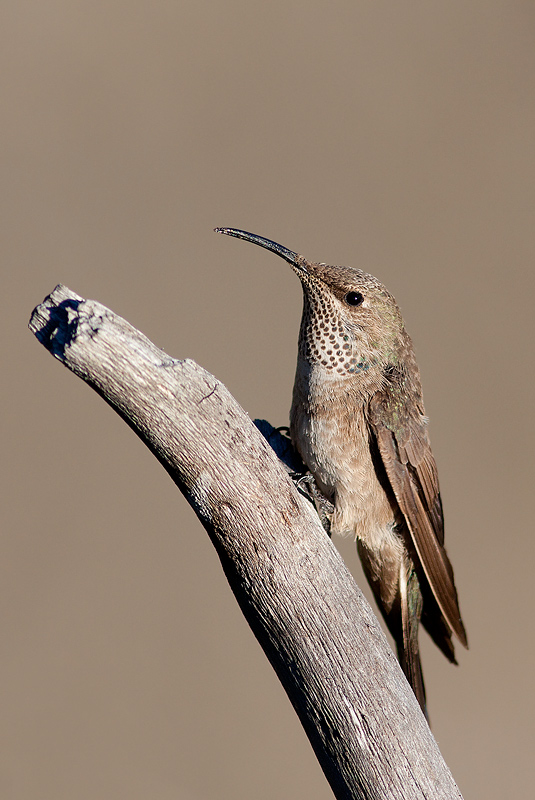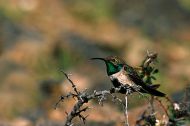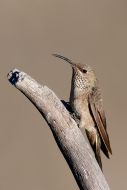White-sided Hillstar
Picaflor Serrano Chico
Oreotrochilus leucopleurus
Length: 127mm. Sexes unlike. Male: bill black; iris very dark brown; upper parts and sides of head, hind neck, above and uppertail coverts olivaceous brown; beyond the orbital region it shows a small white patch; central rectrices olivaceous brown, on either side three tail feathers are
white and the outermost are black with bluish sheen and a white spot in the inner vexillum. Throat, chin, and foreneck bright iridescent green followed by a blue black band or collar; sides of breast and flanks olivaceous brown; remainder of breast and abdomen white with a longitudinal bluish black band; undertail coverts glossy olivaceous brown. Wing coverts olivaceous brown; primary and secondary remiges blackish brown. Legs blackish. Females lack the iridescent patch in neck, instead neck is whitish with specks of greenish brown; breast and belly are whitish brown and lack longitudinal band; the tail has the four central feathers olive brown and the three outermost on either side are white at the base, followed by olive brown and the outer third is white; remainder of plumage as in males. Females are slightly smaller than males, measuring approximately 115mm.
Immature males are similar to females but throat is blackish with a soft greenish and bluish sheen; belly and breast show the typical longitudinal blackish band of males. Habitat and behaviour: readily identified by its coloration and the slightly decurved bill; it is found in pairs or in small groups in those places where food is abundant due to the flowering of a given plant; many couples can breed in areas of limited extension. Despite being independent in the feeding and drinking sites, on occasion adults can be seen together, although males are constantly fighting off competitors.
They inhabit the hill slopes, preferably those environments close to boulders and rock walls. The White-sided Hillstar nests on ledges and shelves in rock walls; the nest, glued to the vertical wall, is made of mosses, lichens and soft-textured plant fibres and is cemented with the bird’s sticky saliva that hardens upon drying and adheres to the rock. Clutch size: two white eggs.
The authors have found nests belonging to the White-sided Hillstar at El Bolsón, Río Negro, in the locality named Piedra Pintada. Also, several pairs spent the spring and summer at El Boquete, Río Negro, 10km northwest of
El Maitén, Chubut, where their numbers varied from year to year according to the amount of thistle available; it is also commonly found where Mutisia plants abound. In addition to the abovementioned places, the authors have found and collected specimens from this species at Cerro Piltriquitrón, in Epuyén, El Maitén and on the road to Cushamen.
Migratory from the northwest of Argentina, this species arrives each year dispersing from Neuquén to Santa Cruz. It occurs in this entire Patagonian region in hills and ravines, and also in the ecotone that separates the steppe from the forests. It remains throughout this region from October to late February, and on the authors’ account, it is very difficult to spot specimens in March.
Range: distributed in Argentina along the Andes up to 3500 metres amsl, from Jujuy to Santa Cruz. It also occurs in the mountainous regions of Chile and Bolivia.
Illustrated Handbook of the Birds of Patagonia
Kindless: Kovacs Family
|










